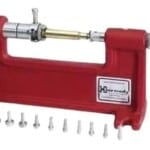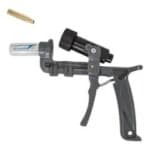
Steps to reload
Reloading your own ammunition, more commonly referred to as "handloading," is a meticulous task that calls for not just the right tools, but also a significant degree of precision, an unwavering attention to detail, and an uncompromising adherence to safety protocols. Here, we lay down the foundational steps to reload ammunition. However, it's crucial to note that this is an overview or the steps to reload rather than an exhaustive guide or a comprehensive instruction manual. Reloading ammunition is not something to be undertaken lightly or without adequate training and understanding.
Let's first discuss the equipment needed in this process:
- Reloading Press: This is the backbone of your reloading operation. A reloading press is used to resize the spent brass, remove the spent primer, insert the new primer, and seat the bullet in the case. Different types of presses are available, and your choice should be based on your budget, the volume of ammunition you plan to reload, and the specific type of ammunition.
- Dies: Dies are essentially the molds for your ammunition. They are caliber-specific and serve various purposes, including resizing the case, expanding the case mouth, and seating and crimping the bullet.
- Brass Cases: Brass cases hold the primer, powder, and bullet. They can be reused several times, which makes reloading a cost-effective option for avid shooters. However, they do wear out and must be inspected for damage before each use.
- Primers: Primers ignite the gunpowder when struck by the firearm's firing pin. They come in different sizes, so it's crucial to choose the correct size for your ammunition.
- Powder: Gunpowder is the propellant used in ammunition. There are many types of powder available, and the correct choice will depend on the caliber of ammunition and the specific load you're developing.
- Bullets: The bullet is the projectile that is fired from the firearm. Like powder and primers, bullets come in many different sizes, shapes, and types. The correct bullet will depend on your firearm and your shooting goals.
- Powder Scale: A powder scale is used to precisely measure the weight of your gunpowder. This is a critical step, as too much or too little powder can lead to dangerous or ineffective ammunition.
- Case Tumbler (Optional): While not strictly necessary, a case tumbler can be useful for cleaning spent brass. This can help extend the life of your brass and can result in more consistent, high-quality ammunition.
- Reloading Manual: A reloading manual provides the data you need to develop safe and effective loads. It will give you the minimum and maximum amounts of powder to use, the correct size and type of primer, and the appropriate type and weight of bullet.
Once you have collected all the necessary equipment, you can begin the actual process of reloading. This is a multi-step process that must be followed in the correct order to ensure safety and effectiveness. Here are the steps to reload:
The first of the steps to reload ammo is to clean the brass. If your brass is dirty or tarnished, it can be cleaned using a case tumbler. While this step is not strictly necessary, it can help prevent unnecessary wear on your dies and press, and it can result in more consistent and reliable ammunition. Besides, who wants to shoot ugly brass?
Once the brass is clean, you should inspect each case carefully. You are looking for any signs of damage, such as cracks or splits. Any damaged cases should be discarded.
The next of the steps to reload is to resize the case. This is done using your reloading press and the appropriate resizing die. The resizing process returns the case to its original dimensions, and often includes the step of depriming, or pushing out the spent primer.
With the case resized and deprimed, you can now prime the case. This involves inserting a new primer into the case. Most reloading presses include a priming tool that can do this. There are also hand tools and bench tools that can be used for priming.
There are dies that flare the case, sometimes these are standalone, and sometimes these are combined with other dies, such as a powder-through expander die that allows you to flare the case and charge the case (add powder) in a single step. The steps to reload are slightly different depending on your die sets.
After the case is primed (or primed and flared), it's time to measure the powder. This is where your powder scale comes into play. You'll need to accurately measure the correct amount of powder for your specific load. It's vital to follow the guidelines in your reloading manual closely here. Start with the minimum recommended load and never exceed the maximum load. Too much powder can lead to dangerous pressure levels in your firearm.
With the powder measured, you can now charge the case. This is simply a matter of carefully pouring the measured powder into the case.
The next of the steps to reload is to seat the bullet. To do this, you place a bullet at the mouth of the case, and then use your press and the appropriate seating die to push the bullet into the case to the correct depth.
After the bullet is seated, you should inspect the completed cartridge. Look for any irregularities, such as uneven crimping, overly deep or shallow bullet seating, or any powder residue on the outside of the case.
Finally, the last of the steps to reload is that you'll need to store your completed cartridges properly. Ammunition should be stored in a cool, dry place, away from heat and flame. You may choose to store cartridges in dedicated plastic boxes, typically sold for the purpose of storing reloaded ammo, or simply reuse the boxes and cartridge holders that come with every purchased box of ammo.
Always remember to follow the manufacturer's instructions for your specific equipment, and never exceed the recommended loads for a given caliber. Incorrectly loaded ammunition can be dangerous or even deadly. The steps to reload are a complex process that requires a significant amount of knowledge and skill. If you're new to reloading, it's strongly advised that you learn from an experienced person before attempting to do it on your own. Furthermore, it's important to note that the steps to reload might slightly differ based on the specific caliber and equipment you are using.
Reloading ammunition is a time-honored hobby for many firearms enthusiasts. It offers a greater understanding of how ammunition works, it allows shooters to customize their ammunition for their specific needs, and it can be a cost-effective way to supply your shooting hobby. However, it's not something to be undertaken lightly. It requires a significant investment in equipment, a good deal of time and patience, and a commitment to learning and adhering to safe practices. If you're considering getting into reloading, it's important to do your research, get the proper training, and always follow the steps to reload and safety guidelines.
We recommend that you join a forum where you can read about reloading, and ask questions of others and learn about other peoples concepts of the steps to reload. Here's a good forum for that.
Click here to get yourself a good reloading manual.
If you know of any forums or sites that should be referenced on this listing, please let us know here.




